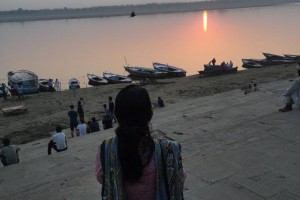OF DEAD COWS AND THE GANGA: THE PARADOX OF RELIGION
A dead cow is floating down the river Ganga. She is a black-and-white Holstein Friesian cow, like the one I own in Bangalore. She floats sideways, legs spreadeagled. Half of her face is visible, even though it is dark—7pm on a Friday. I wish I could say that she looks peaceful, but her teeth are bared.
Some 100 boats filled with Indian and foreign tourists are converging on Dashashwamedh Ghat for the evening Ganga aarthi, the spectacle that is the culmination of daily religious life in Kashi. The cow floats amid the boats, forcing embarrassed guides into stuttering, apologetic explanations in Spanish, French, Russian, Hebrew and English.
“Sometimes, when people have a pet cow that died and they cannot afford to bury or cremate her, they simply throw her into the Ganga,” says our guide, J.P. Mishra, of Magic India Tours. He stares at our horrified faces and shrugs. “Ganga is the mother. She accepts everything.”
Would the Ganga have been better served, had we imagined her to be our child rather than mother? What if our ancients imagined the Ganga to be a daughter, or better yet, given the Indian preference for male heirs, a son? Would we have taken better care of Ganga, our child, than we do of Mother Ganga?
These are moot questions; whispers into the mists of time that reach back to 1500 BC when the Vedas were “revealed” (not written or composed but revealed, but more on that later) to Hindu rishis. The first Veda, the Rig Veda, mentions the Ganga but a few times. The most famous reference to the Ganga in the Rig Veda comes from thenadistuti sukta, or the “hymn in praise of the rivers”. Even that mentions the Ganga somewhere in the middle, along with nineteen other rivers—including the Saraswati, Yamuna, Purushni, Asikni and Gomti.
The hymn is predominantly in praise of the river Sindhu, or Indus, described as the mightiest of all rivers, into which other roaring rivers run “like mothers to their calves”, not calves to their mothers as I first mistakenly thought. The Sindhu—who flows flashing and white, with ample volume; whose roar can be heard to the heavens; who bellows like a bull; and who is beautiful like a steed. Ganga is just part of a list in these early days of Hinduism.
Click here for more…

